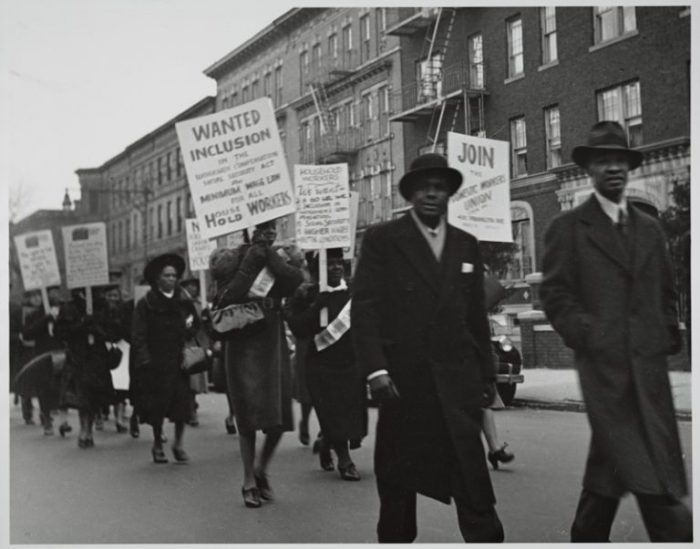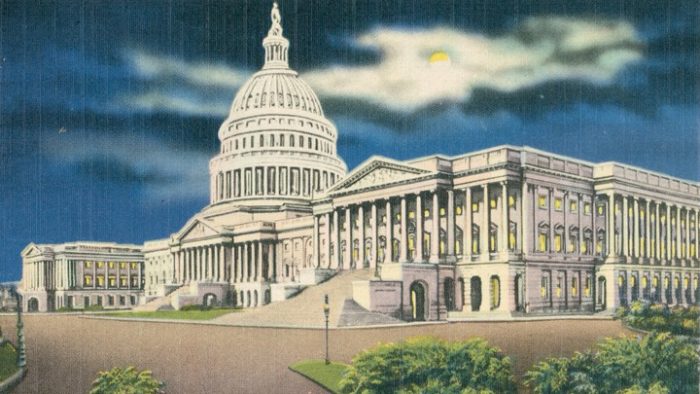ICYMI: Highlights from the week that was Feb. 15 – 21, 2020
No one can keep up with everything, so let us do it for you. We’ll gather the top Smithsonian stories from across the country and around the world each week so you’ll never be at a loss for conversation around the water cooler.
There’s lots of news this week, and not all of it is coming out of New York.

Art and Design
The Wedding Dress Saga: Conflict of Interest Does Damage at Design Museum
Nonprofit Quarterly, February 20
t appears Nonprofit Quarterly must keep beating the drum about conflicts of interest, since nonprofit executives continue to damage their reputations and their institutions by disregarding those rules.
The director of Cooper Hewitt Smithsonian Design Museum in New York, Caroline Baumann, resigned on February 7th after an investigation by the Smithsonian’s inspector general. An anonymous complaint by a staff member brought up questions about the venue and dress for Baumann’s 2018 wedding. Read more.
Several Cooper Hewitt Board Members Resign as Details of Director’s Departure Emerge
David Rockwell and other board members have resigned in response to Caroline Baumann’s exit
Architectural Digest, February 18
Earlier this month, it was reported that Caroline Baumann resigned her post as director of the Cooper Hewitt Smithsonian Design Museum with little explanation. Now, a wave of resignations by Cooper Hewitt board members has put a spotlight on both the process and the ultimate outcome of a Smithsonian investigation that triggered Baumann’s departure. Read more.
How a $750 Wedding Dress Led to a Trustee Revolt at the Cooper Hewitt
Caroline Baumann was forced to resign as director of the museum, reportedly after an investigation into alleged conflicts of interest around her wedding. But the dress’s designer, and a half dozen trustees, are crying foul.
Vanity Fair, February 18

Photo by Rob Kim/Getty Images
Caroline Baumann’s February 7 resignation as director of the Cooper Hewitt, Smithsonian Design Museum came as a surprise. There hadn’t been reports of turmoil, she’d previously steered a $91 million renovation of the Carnegie Mansion where the museum is located, and no explanation was given at the time for her stepping down. In the 10 days since the sudden and murky departure, museum trustees have resigned in protest, and the most granular account of the situation has come from a fashion designer who says she never offered Baumann a discount and accused an agent of making an “astronomically shocking and inappropriate” statement in the course of a federal investigation. Read more.
Designer Samantha Sleeper Discusses Controversy Over Former Cooper Hewitt Director’s Wedding Dress
The Cooper Hewitt controversy has resulted in Sleeper receiving more dress inquiries from prospective clients, which curiously is what investigators alleged she was after.
WWD, February 21
Two weeks after Cooper Hewitt, Smithsonian Design Museum director Caroline Baumann was forced to resign over questions of how she procured her wedding dress and venue, the dress’ designer Samantha Sleeper insisted there was no impropriety. Read more.
6 Cooper Hewitt Trustees Resign After Director’s Removal
The board members said they should have been consulted before the Smithsonian asked Caroline Baumann to resign after an investigation.
The New York Times, February 17
Read the full article: 6 Cooper Hewitt Trustees Resign After Directors Removal – The New York Times
Ousted Cooper Hewitt Director Calls Investigation a ‘Sham”
The New York Times, February 20
Read the full article: Ousted Cooper Hewitt Director Calls Investigation a Sham – The New York Times
Smithsonian Provost overseeing Cooper Hewitt after ouster of director
Caroline Baumann was reportedly forced to resign from the New York museum after concerns raised about her 2018 wedding
The Art Newspaper, February 18
Read the entire article: Smithsonian provost overseeing Cooper Hewitt after ouster of director _ The Art Newspaper
History, Culture and Education
How the Smithsonian Is Documenting the Work of Immigrant Rights Activists
A new collecting initiative will tell the stories of the undocumented and their political organizing movements
Smithsonian, February 21

“New Paths to Change: Undocumented Immigrant Activism, 2000 to the Present” is an curatorial effort to collect the stories community organizers across the nation (above: a 2017 immigration rally in San Francisco). ( Pax Ahimsa Gethen, Wikimedia Commons)
On November 12, 2019, curators from the National Museum of American History assembled at the U.S. Supreme Court as observers, and collectors, of history. That day, the justices heard three cases pertaining to the status of the Deferred Action for Childhood Arrivals (DACA) program. Positioned both inside the courtroom and outside on the steps, the museum team witnessed the proceedings and protests, and considered how best to capture the moment in material, objects and oral histories, or recordings, that would then be housed in the Smithsonian collections. Read more.
Smithsonian Is Looking For Help Digitizing A Historic D.C.-Based Black Newspaper
DCist, February 20

Untitled, 1930-49. Photograph by Joe Schwartz of domestic workers marching with picket signs.
Collection of the Smithsonian National Museum of African American History and Culture, Gift of Joe Schwartz and Family
Sure, Black History Month is more than half over, but it’s not too late to get involved in an ongoing history project that honors the culture, struggles, and resiliency of the African American community during the Great Depression.
Led by the Smithsonian’s Transcription Center—which launched in 2014—volunteers have helped transcribe more than 1,500 pages from collections at the National Museum of African American History and Culture and the Anacostia Community Museum. The collection has been recently digitized and added to the transcription project list. It includes fragile newspapers, political pamphlets, and ads for black entertainers from the 1930s. Read more.
Kevin Gover on Native Americans and American History (Video)
National Museum of the American Indian Director Kevin Gover discussed the museum’s history, artifacts and issues of importance to Native Americans today.
C-Span, February 20
Anthea Hartig on Women’s Suffrage and 19th Amendment’s Centennial (Video)
In commemoration of the 19th Amendment’s centennial, Smithsonian National Museum of American History director Anthea Hartig took questions about the long campaign to win women the vote, the struggle for women’s rights and the artifacts in their custody that tell the story, including a slogan-covered wagon suffragists used to press their case. Ms. Hartig is the museum’s first female director since it opened in 1964.
Smithsonian looks to preserve personal black histories by digitizing home movies
WJLA ABC7, February 17
The Smithsonian’s Museum of African American History and Culture is offering to digitize home movies for free in order to preserve an important part of black history.
The program is called “The Great Migration Home Movie Project.” A team of experts says they’ve already digitized nearly 700 films so far, uncovering everything from an Afro-futurism family reunion to soldiers returning home. Read more.
Anacostia Community Museum illuminates, amplifies, and connects the city’s neighborhoods
WJLA ABC7, February 17
The museum was created 52 years ago. It’s more than four miles from most of the other Smithsonian museums on the National Mall.
That was the goal from the start, a community-based institution that brings history into the neighborhoods, specifically Anacostia.
Melanie Adams is the new director of the Smithsonian Anacostia Community Museum. Read more.
Science and Technology
An elephant’s story does not end when it dies
The Washington Post, February 21

Noor, a young female elephant, is pictured in 2013 observing the corpse of Victoria, a 55-year-old matriarch that had recently died in Kenya’s Samburu National Park.
But that was not the end of Victoria’s story. Read more.
What’s Source of ‘Stinging Water’? Jellyfish Release Toxic Mucus
U.S. News & World Report (Health Day News), February 19
The mystery of “stinging water” has been solved, scientists say.
Stinging water is the seawater near and around upside-down jellyfish (Cassiopea) — and swimmers can get stinging, itchy skin while submerged in it, even if they have no direct contact with the creatures themselves. Read more.
Various subjects
Trump’s Beautiful Proposal for Federal Architecture
The classicists hope to address a problem that the architecture establishment does not see as a problem.
The Atlantic, February 20

SMITH COLLECTION / GADO / GETTY
I hope members of the National Civic Art Society are just perverse enough to be rather pleased with themselves right about now. The NCAS is the group of activists behind the draft executive order informally called “Making Federal Buildings Beautiful Again.” The draft, which was leaked earlier this month to an architecture trade publication, strongly encouraged architects to adopt a classical style when they design federal courthouses and buildings in the nation’s capital. The Trumpian title of the order was itself a mischievous provocation, and the name hit the bull’s-eye. Read more.
Women’s History Museum Legislation
House passes bill to establish a national woemn’s history museum
CBS News, February 18
A museum dedicated to women’s history is one step closer to join the monuments and museums on the National Mall in Washington, D.C. The House of Representatives voted overwhelmingly last week to approve a bipartisan bill called the Smithsonian Women’s History Museum Act. Now it heads to the Senate. Read more and watch the video)
With bipartisan support, a Smithsonian women’s history museum is closer to reality
CNN, February 18
A Smithsonian museum dedicated to women’s history is a step closer to reality after the House of Representatives overwhelmingly approved a bill to create one. It now heads to the Senate.
H.R. 1980, also known as the Smithsonian Women’s History Museum Act, passed 374-37 last week. Read more.
Momentum builds in Washington, Congress to have museum dedicated to American women’s history
Rep. Carolyn B. Maloney (D) of North Carolina was the main sponsor of the Smithsonian Women’s History Museum Act, which 374 Congress members supported.
WUSA9 (Via Associated Press), February 16
Momentum is building in Washington for the creation of a museum dedicated to American women’s history.
The House has passed a bill to establish the museum inside the Smithsonian network and take steps toward funding and construction.
Rep. Carolyn B. Maloney (D) of North Carolina was the main sponsor of the Smithsonian Women’s History Museum Act, which is what the bill in the House is being called. Read more.
Posted: 24 February 2020







